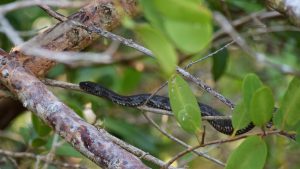Today is the International Day for the Conservation of the Mangrove Ecosystem. Adopted by the General Conference of UNESCO in 2015 and celebrated each year on 26 July, this day aims to raise awareness of the importance of mangrove ecosystems and to promote solutions for their sustainable management, conservation, and uses.
An ecosystem is a biological community of interacting organisms and their physical environment. Mangrove ecosystems are those dominated by mangrove trees and shrubs that live in the coastal and intertidal zone in subtropical and tropical latitudes. In Florida, we have three species of mangroves, the red mangrove (Rhizophora mangle), the black mangrove (Avicennia germinans), and the white mangrove (Laguncularia racemosa).
Mangroves are special and unique ecosystems; they provide many services to people, such as:

- Mangroves help stabilize coastline ecosystems and prevent erosion.
- Mangroves provide natural infrastructure and protection to coastal communities by absorbing storm surge impacts during hurricanes and other extreme weather events.
- Mangroves help bind and build soils, with their intricate, above-ground root systems slowing water flows and facilitating sediment deposition.
- Mangrove roots also filter nutrients and pollutants from the water, improving the quality of the water flowing from rivers and streams into estuaries and, eventually, the ocean.
- Mangroves sequester great amounts of carbon dioxide, with mangrove forests among the most effective forests at capturing, trapping, and storing carbon dioxide.
- Mangrove forests provide food and subsistence to people, as coastal mangrove shorelines and tree roots are critical spawning and nursing habitat for an array of marine species.
- Mangrove forests provide habitat and refuge to diverse wildlife such as birds, fish, invertebrates, land and marine mammals, and plants.
- Mangrove forests give us a place to observe wildlife and connect with nature.

Despite the services mangroves provide to us and many different organisms, mangrove ecosystems are among the most threatened ecosystems on earth. In the past 50 years, it has been estimated, that we have lost about 50% of mangrove ecosystems. Luckily, in Florida, mangroves are protected, but just like in other places around the globe, mangrove ecosystems have declined and need our help.
Please join me today and every day to learn, celebrate, and care for one of the most fascinating ecosystems on Earth, the mangrove ecosystem.
Happy International Day for the Conservation of the Mangrove Ecosystem.
 0
0
